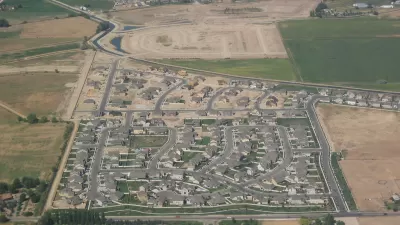This piece from Miller-McCune looks at the conservation easement and explains how the legal device is being used to protect land and prevent sprawl.
According to this article, the number of land trusts increased 32% between 2000 and 2005. Many expect that trend to continue due to this recession.
"This legal device makes good use of the dictum that says you have to give something to get something - in return for losing potential profit by preserving natural features, the landowner gets a tax break.
These easements are usually between a private landowner and a public or government agency that restricts the amount and type of development and protects the property's natural resources in perpetuity.
It's not a new concept. Thomas Tyner, regional counsel for the Northwest and Rocky Mountain region of the Trust for Public Land in Seattle, says the first conservation easement occurred in New England around the mid- to late 1800s."
FULL STORY: Earth to Stand on — Conservation Easements

Planetizen Federal Action Tracker
A weekly monitor of how Trump’s orders and actions are impacting planners and planning in America.

Map: Where Senate Republicans Want to Sell Your Public Lands
For public land advocates, the Senate Republicans’ proposal to sell millions of acres of public land in the West is “the biggest fight of their careers.”

Restaurant Patios Were a Pandemic Win — Why Were They so Hard to Keep?
Social distancing requirements and changes in travel patterns prompted cities to pilot new uses for street and sidewalk space. Then it got complicated.

Platform Pilsner: Vancouver Transit Agency Releases... a Beer?
TransLink will receive a portion of every sale of the four-pack.

Toronto Weighs Cheaper Transit, Parking Hikes for Major Events
Special event rates would take effect during large festivals, sports games and concerts to ‘discourage driving, manage congestion and free up space for transit.”

Berlin to Consider Car-Free Zone Larger Than Manhattan
The area bound by the 22-mile Ringbahn would still allow 12 uses of a private automobile per year per person, and several other exemptions.
Urban Design for Planners 1: Software Tools
This six-course series explores essential urban design concepts using open source software and equips planners with the tools they need to participate fully in the urban design process.
Planning for Universal Design
Learn the tools for implementing Universal Design in planning regulations.
Heyer Gruel & Associates PA
JM Goldson LLC
Custer County Colorado
City of Camden Redevelopment Agency
City of Astoria
Transportation Research & Education Center (TREC) at Portland State University
Camden Redevelopment Agency
City of Claremont
Municipality of Princeton (NJ)




























